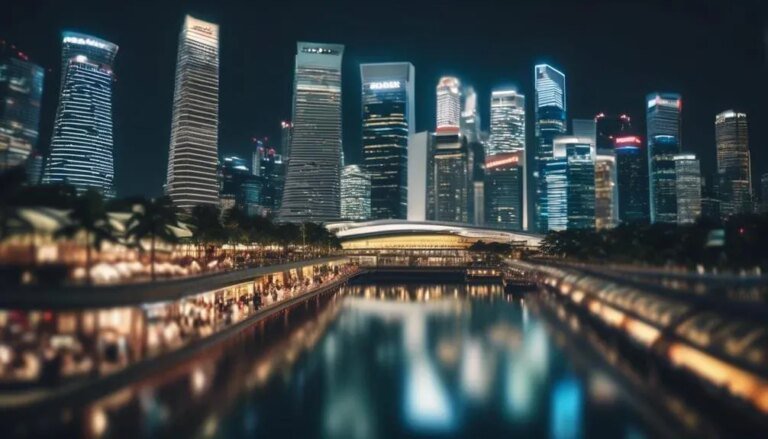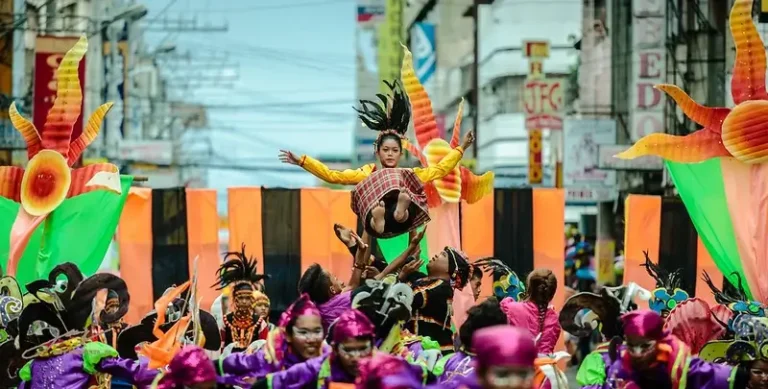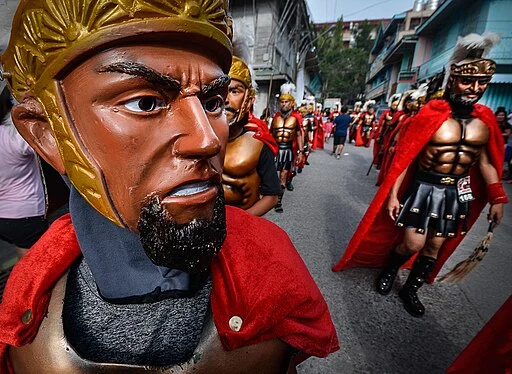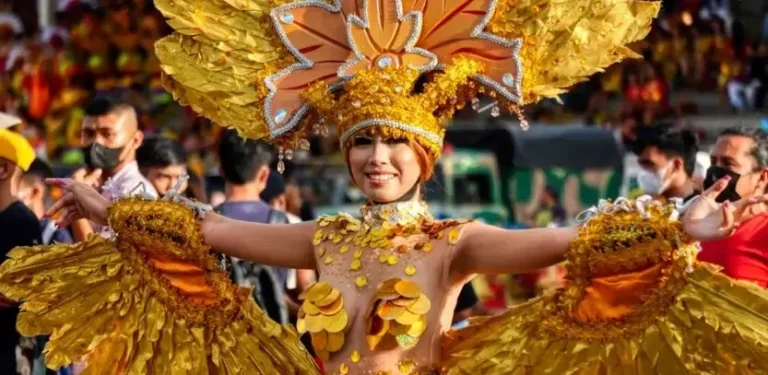Sinukwan Festival Pampanga Philippines
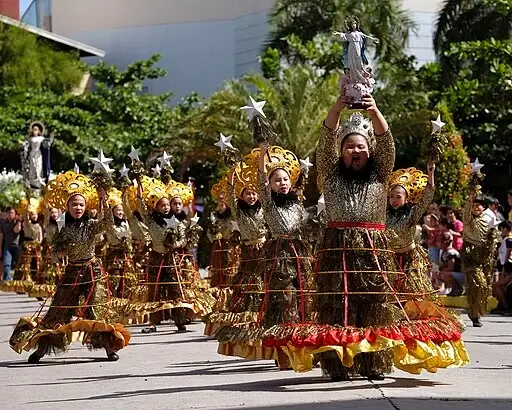
Image Credit: Wikimedia Commons
Imagine strolling through the vibrant streets of Pampanga during the Sinukwan Festival, where the air is thick with the scent of local delicacies and the sounds of traditional Kapampangan music.
You’re witnessing a cultural spectacle that celebrates not just the harvest but also the rich heritage of the region. The festival is named after the ancient god Sinukwan, representing the sun and agriculture, and you’ll find that it’s a time when the Kapampangans pay homage to their divine protector and their identity.
As you observe the colorful parades and the rhythmic Sinukwan dances, you’re not just a spectator; you’re an active participant in preserving the traditions that define freedom for the people of Pampanga.
Continue reading to learn about the myths, about customs, of the Sinukwan Festival to ignite your appreciation for the enduring spirit of the Kapampangan people.
Facts About Sinukwan Festival Philippines
| Facts | Explanation |
|---|---|
| Name of the festival | Sinukwan Festival |
| Type of festival | Cultural and historical festival |
| Brief history of the festival | The Sinukwan Festival is celebrated in Pampanga, Philippines, showcasing the rich cultural heritage and traditions of the Kapampangan people. It was established in 1993 to honor and preserve the unique customs, folklore, and arts of the province. The festival takes its name from the Kapampangan word “Sinukwan,” which means “ancestral heritage” or “cultural legacy.” Throughout the festival, various activities, performances, and exhibits are held to promote and celebrate the local culture. |
| Brief history of the city | Pampanga is a province located in Central Luzon, Philippines. It was founded by the Spaniards in 1571 and has since become an important center for trade and commerce. The province has a rich history and is known for its significant role during the Philippine Revolution against Spanish rule. Pampanga is often referred to as the “Culinary Capital of the Philippines” due to its diverse and flavorful cuisine. The city where the Sinukwan Festival is celebrated is Angeles City, which was once a major airbase of the United States during World War II. It is now a thriving urban center with a vibrant cultural scene. |
| Location of the city | Angeles City is located in the province of Pampanga, which is situated in Central Luzon, Philippines. |
| How to reach the city | – By air: Clark International Airport is the main gateway to Angeles City, with regular domestic and international flights. – By land: Angeles City is accessible via major highways and roads. Buses, vans, and taxis provide transportation options from Manila and other nearby cities. |
| Nearby cities or towns | – San Fernando City (Pampanga) – 10 km – Mabalacat City (Pampanga) – 15 km |
| Google map link | Angeles City on Google Maps |
| Ethnic information | The Kapampangan people are the predominant ethnic group in Pampanga. They have a distinct culture and language, known as Kapampangan. The Kapampangan cuisine is famous for its use of ingredients like rice, pork, and seafood, resulting in flavorful dishes such as sisig (a sizzling pork dish), Bringhe (a local version of paella), and Kakanin (various traditional rice cakes). |
| Festival main events and activities | – Street parade featuring colorful floats, street dancers, and marching bands – Cultural shows showcasing traditional music, dance, and theatrical performances – Trade fairs and exhibits highlighting local crafts, products, and delicacies – Beauty pageants and talent competitions |
| Festival Etymology | The term “Sinukwan” is derived from the Kapampangan word for “ancestral heritage” or “cultural legacy.” It symbolizes the festival’s aim to preserve and promote the rich traditions and customs of Pampanga. |
| Other famous tourist attractions in the city | – Mount Pinatubo Crater Lake – Nayong Pilipino Clark Park – Holy Rosary Parish Church (Santo Rosario Church) |
| Famous food dishes of the city | – Sisig: A sizzling pork dish made from chopped pig’s head, onions, and chili peppers – Kakanin: Traditional rice cakes made from glutinous rice and coconut milk, such as Bibingka (rice cake topped with salted egg and cheese) and puto (steamed rice cake) – Bringhe: A local version of paella made with glutinous rice, chicken, coconut milk, and various vegetables |
| Landmarks in the city | – Clark Museum and 4D Theater – Holy Angel University Chapel: A beautiful chapel known for its stained glass windows and intricate design – Salakot Arch: A symbolic gateway to Angeles City with a giant Salakot (traditional Filipino hat) structure |
| Related festivals in the same region | – Giant Lantern Festival (San Fernando City) – showcases giant lanterns made by different barangays (villages) in San Fernando City during the Christmas season. – Sinulog Festival (Cebu City) – a religious and cultural festival honoring the Santo Niño (Child Jesus) with street dances and processions. |
Historical Significance of Sinukwan Festival in Pampanga, Philippines
The Sinukwan Festival traces its roots to the Kapampangan god of ancient mythology, Aring Sinukwan, embodying the region’s rich cultural heritage.
You’ll find that this vibrant celebration honors the festival deity with an outpouring of music, dance, and colorful attire, reviving the spirit of Pampanga’s storied past. It’s a powerful symbol of identity and freedom for the Kapampangans.
Aring Sinukwan is said to be the deity of the ancient Kapampangans, who watched over their agricultural endeavors. This connection is brought to life in the festival, highlighting the region’s deep agricultural connections.
The rhythmic dances and chants during the festival pay homage to the bountiful harvests and the land’s fertility, keeping the community’s ties to their land and traditions fiercely alive.
Kapampangan Festival Significance
You’re about to uncover why the Sinukwan Festival is more than just an annual celebration; it’s a vibrant expression of Kapampangan identity.
This festival isn’t just about colorful parades and dances; it’s a testament to the region’s rich heritage and a way to honor ancestral traditions.
As you explore the significance of this event, you’ll see how it brings the community together, forging a sense of unity and pride among the people of Pampanga.
Cultural Identity Preservation
By immersing yourself in the vibrant Sinukwan Festival, you’ll witness firsthand how Kapampangans preserve their rich cultural identity through traditional music, dance, and costumes.
This celebration isn’t just a feast for the eyes; it’s a testament to the enduring spirit of a people dedicated to safeguarding their heritage.
- Cuisine showcase: Savor the symphony of flavors in Kapampangan dishes, an integral part of the festival that tantalizes taste buds and nourishes cultural pride.
- Language revitalization: Listen to the poetic Kapampangan language in songs and stories, a crucial effort in keeping the linguistic traditions alive.
- Engage in folk dances and ancient rituals: Connecting you to the ancestral heartbeat of Pampanga.
- Admire the vibrant costumes: Each thread is woven with the history and soul of the Kapampangan people.
Heritage Celebration
Delving into the Sinukwan Festival, you’ll discover a profound celebration that encapsulates the Kapampangan people’s dedication to their ancestral heritage.
This vibrant event isn’t just a display of colorful costumes and lively dance routines; it’s a testament to the enduring spirit of a culture that thrives through the ages.
The festival cuisine is an integral part, with heirloom recipes and traditional dishes brought to life, tantalizing your taste buds and connecting you to generations past.
Moreover, the Sinukwan Festival has a significant economic impact, stimulating local businesses and attracting tourists eager for a taste of freedom and festivity.
You’re not just watching a parade; you’re participating in a living economy that flourishes with every beat of the drum and every shared meal.
Community Unity Display
As you immerse yourself in the Sinukwan Festival, you’ll witness the community coming together, showcasing a unity that transcends individual differences and celebrates their collective identity.
The festival isn’t just about vibrant parades and cultural exhibitions; it’s a powerful expression of communal spirit.
Here’s what brings everyone together:
- Festival Economics: The festival stimulates local businesses, creating a bustling marketplace where everyone benefits.
- Communal Feasting: Tables groan under the weight of shared Kapampangan delicacies, forging bonds over food.
- Cultural Performances: Locals of all ages participate in dance and music, displaying their heritage with pride.
- Craftsmanship Exhibits: Artisans collaborate to showcase traditional crafts, inviting admiration and respect for their skills.
This celebration of unity isn’t just felt; it’s lived and breathed, reinforcing the freedom of a community in harmony.
Unveiling Sinukwan Myths
Discover the legends shrouding Sinukwan, a deity integral to Kapampangan folklore, whose stories anchor the festival’s vibrant celebrations.
You’re not just observing a spectacle; you’re stepping into a narrative tapestry woven from the mythic origins of the Kapampangan people. Sinukwan, revered as a god of the ancient realm, is said to embody the spirit of nature and the strength of the ancestors.
While embracing the enchantment of these tales, you’ll also encounter festival controversies. Debates often arise over the interpretation of these myths and their place in modern festivities.
Yet, such discussions reflect a community’s dynamic relationship with its heritage, where you’re encouraged to question, understand, and even redefine freedom within the context of cultural expression.
Celebrating With Cultural Dances
Every year, you’ll witness countless dancers take to the streets, their movements echoing the ancestral heartbeat of the Sinukwan Festival. These performances aren’t just impromptu; they’re the result of meticulous preparation and passion for cultural preservation. Here’s what sets the scene:
- Dance workshops blossom across Pampanga, inviting you to immerse yourself in the traditional moves, embodying the festival’s spirit with every step.
- Participants showcase costume innovation: Where traditional meets contemporary, crafting visual stories that captivate your senses.
- The streets become stages of freedom: Where dancers express their heritage with pride and joy, unshackled by the mundane.
- You’re not just an observer; you’re invited to feel the pulsating energy, and perhaps even find yourself swaying along, celebrating liberation through the art of dance.
Preserving Pampanga Heritage
As you revel in the vibrant Sinukwan Festival, it’s crucial to recognize the role of cultural education initiatives in keeping Pampanga’s heritage alive for future generations.
Heritage conservation efforts ensure that the province’s historical landmarks and traditions withstand the test of time. Meanwhile, the revival of traditional crafts provides a tangible connection to the past, fostering a sense of pride and continuity in Kapampangan culture.
Cultural Education Initiatives
You’ll find that the Sinukwan Festival serves as a dynamic classroom, immersing participants in the rich tapestry of Pampanga’s cultural heritage through vibrant performances and educational activities.
Engaging with the festival, you’re not just celebrating; you’re actively preserving a way of life. Here’s how:
- Cultural Workshops: Dive into hands-on experiences that teach traditional crafts and Kapampangan arts, ensuring skills are passed down.
- Educational Outreach: Schools and communities engage with historians and cultural bearers, fostering a deeper understanding of local history.
- Performing Arts: Witness the dramatization of folk tales and ancestral stories through music and dance.
- Cuisine Classes: Learn to cook authentic Kapampangan dishes, savoring flavors that are as much about identity as they are about taste.
Each initiative is a step towards liberty and freedom to express, preserve, and celebrate your unique cultural heritage.
Heritage Conservation Efforts
While exploring the Sinukwan Festival, you’re not only participating in vibrant celebrations but also contributing to the preservation of Pampanga’s unique heritage.
Your presence supports the cultural legislation that protects these traditions and encourages the local government to invest in artifact restoration.
Engage with the festival and you’re actively safeguarding the freedom to celebrate and pass on these cultural gems. It’s about keeping the spirit of Pampanga alive for future generations.
| Aspect | Details |
|---|---|
| Cultural Legislation | Laws preserving local traditions |
| Artifact Restoration | Reviving historical items |
| Community Involvement | Locals maintaining traditions |
| Education & Outreach | Spreading awareness of heritage |
Traditional Crafts Revival
Every participant at the Sinukwan Festival plays a crucial role in the revival of Pampanga’s traditional crafts, a cornerstone of the province’s cultural heritage.
As you immerse yourself in the vibrant festivities, you’re also becoming part of a movement that cherishes freedom and creativity. Here’s how you can engage:
- Join Crafts Workshops: Roll up your sleeves and dive into hands-on experiences, from weaving to woodcarving.
- Attend Artisan Exhibitions: Witness the intricate beauty of local craftsmanship and meet the makers.
- Support Local Artisans: Purchase their works, boosting both their livelihood and the preservation of these arts.
- Spread the Word: Share your experiences and newfound knowledge to inspire others.
You’re not just celebrating; you’re actively safeguarding Pampanga’s rich artistic tapestry for generations to come.
Mount Arayat Legends
Mount Arayat’s mystique, deeply woven into Kapampangan folklore, envelopes you in tales of gods, enchantments, and hidden realms. Unlike the explosive history of nearby Mount Pinatubo, Arayat’s legends are more serene yet equally captivating.
As you embark on Arayat trekking, imagine the ancient spirits whispered to still roam the dense forests. You’re stepping into a world where mythical beings are as real as the ground beneath your feet.
Local lore speaks of a kingdom suspended in the mountain’s mist, a place of unparalleled beauty and peace, untouchable by those who don’t believe. It’s a symbol of freedom, a testament to the unyielding spirit of the Kapampangans, a people as enduring as the mountain itself. Embrace the adventure, and let the legends guide your journey.
Aeta Tribes of Pampanga
Why haven’t you heard more about the Aeta tribes, whose ancestral lands are nestled in the shadow of Pampanga’s storied peaks? These indigenous people live with a profound connection to the land, maintaining traditions that have been passed down for generations.
They are the unseen guardians of the forests, and their culture is a treasure that’s often overlooked. Here’s what you’re missing out on:
- Aeta Handicrafts: Intricately woven baskets and vibrant accessories that showcase their skill and artistry.
- Traditional Attire: Colorful, handcrafted clothing that tells a story of their heritage.
- Indigenous Cuisine: A taste of freedom, their food is a reflection of the land’s bounty, rich with flavors that you won’t find anywhere else.
- Cultural Practices: Rituals and dances that celebrate their connection to nature and their ancestors.
Dive into their world, and you’ll discover a vibrant culture that’s as free as the wind on the peaks they call home.
Showcasing Philippine Costumes
Having explored the Aeta tribes’ rich heritage, you’ll be captivated by the vibrant Philippine costumes on full display during the Sinukwan Festival. The festival is a canvas of cultural expression, where costume materials are not just adornments but symbols of identity and tradition.
The table below will give you an insight into the costumes’ significance:
| Element | Significance | Fashion Influence |
|---|---|---|
| Colorful Weaves | Cultural Identity | Bold Patterns |
| Indigenous Fibers | Sustainability | Eco-Friendly Fashion |
| Ornate Headdresses | Ancestral Celebration | Statement Accessories |
You’ll notice that these elements are not just about aesthetics; they represent a freedom to express and preserve a rich history.
As you wander through the festival, let the colorful tapestry of Philippine fashion influence your sense of style and cultural appreciation.
Sinukwan Dance Rituals
As you immerse yourself in the Sinukwan Festival’s energetic atmosphere, you’ll be enthralled by the intricate dance rituals that are steeped in Kapampangan history and mythology.
The Sinukwan dance rituals embody a celebration of freedom and cultural identity, and they tell a story through movement. Here’s what makes these dances so captivating:
- Dance Attire: Vibrant and colorful costumes reflect the region’s rich tapestry, enhancing the visual spectacle.
- Rhythmic Patterns: The heart of each dance, dictates the flow and energy of the performance.
- Synchronized Movements: Performers move in unison, showcasing their deep connection with one another and their heritage.
- Symbolic Gestures: Each motion carries meaning, from honoring deities to illustrating daily life.
You’ll leave with a renewed appreciation for the art of storytelling through dance.
Summary of Sinukwan Festival Philippines
| Aspect | Details |
|---|---|
| Location | San Fernando City, Pampanga, Philippines |
| Festival Type | Cultural Festival |
| Main Highlights | Street dances, particularly to the tune of ‘Atin Cu Pung Singsing’ |
| Honor to Aring Sinukwan (King Sinukwan), an ancient Kapampangan deity | |
| Involvement | -Participation from various schools and local barangays -Cultural shows, pageants, photography competitions |
| Attractions | – Local cuisine at food fairs – Crafts fair section |
| For Families | Kid-friendly with loads of fun activities |
| Annual Timing | December (sometimes starting in late November) |
| Tourism Impact | Attracts local and foreign tourists, benefits local businesses |
| Purpose of Festival | – Honors the deity King Sinukwan – Unifies community sectors – Promotes city tourism and improves local livelihood |
| Costumes and Music | – Large crowns, headdresses, vibrant clothing – Native musical instruments for tribal music |
For more detailed information or planning to visit, you can check the following resources:
Please note that the links provided are for reference purposes and may require further searching to find specific details regarding the Sinukwan Festival.
Anticipating Sinukwan Festival 2024 Schedule
Explore the vibrant schedule of events at Sinukwan Festival 2024 in Luzon, Philippines, building on the cultural splendour of previous editions. Calls to institutionalize this celebration underscore its significance, following the success of Sinukwan Festival 2023 held from November 30 to December 8. Stay updated with live events on Sinukwan Pampanga’s Facebook.
Surprising Facts About The Sinukwan Festival
- 🌄 Mount Sinukuan Connection: The Sinukwan Festival is named after Apu Sinukuan, the mountain deity of Mount Arayat in Pampanga, Philippines. The festival is a celebration of the culture and heritage associated with this mystical mountain.
- 🎭 Colorful Street Parade: One of the highlights of the Sinukwan Festival is the vibrant street parade featuring colourful costumes, traditional dances, and lively music. Participants showcase the rich folklore and history of the region.
- 🌺 Floral Offerings: During the festival, it is a tradition for participants and attendees to offer floral garlands and arrangements to Apu Sinukuan as a form of respect and gratitude for the bountiful harvest and blessings.
- 🎨 Indigenous Art Exhibit: Sinukwan Festival promotes local artists by organizing an indigenous art exhibit that showcases the talents and creativity of the people in the region. This helps in preserving and promoting the indigenous art forms.
- 🍢 Kapampangan Culinary Showcase: The festival also serves as a platform to exhibit the unique and delectable Kapampangan cuisine. Food stalls and culinary events allow visitors to experience the rich gastronomic heritage of the region.
- 🎶 Traditional Music and Instruments: Sinukwan Festival features traditional music performances accompanied by indigenous instruments such as kulintang, agung, and gangsa. This adds a distinct cultural flavour to the festivities.
- 🏞️ Eco-Friendly Advocacy: The festival actively promotes environmental awareness and conservation. Events like tree planting and eco-friendly parades aim to instil a sense of responsibility for the natural beauty of the region.
- 🎆 Fireworks Extravaganza: To cap off the festivities, a spectacular fireworks display lights up the night sky. This grand finale is a breathtaking visual treat for both locals and visitors alike.
- 🤹 Street Performers and Buskers: Sinukwan Festival encourages street performances and busking, providing a platform for local artists and performers to showcase their talents in music, dance, and other forms of entertainment.
- 🏰 Historical Reenactments: The festival includes historical reenactments that depict significant events in the region’s history. This immersive experience allows attendees to learn about the cultural and historical roots of the Kapampangan people.
Conclusion
The Sinukwan Festival is a vibrant cultural celebration deeply rooted in honoring the legacy of King Sinukwan, an ancient deity venerated by the Kapampangan people.
This festive tribute dates back to an era with no precise origin year, yet it has become an integral part of the region’s heritage, observed annually with great enthusiasm.
Initially, the festival’s primary purpose was to pay homage to the mythological King Sinukwan, also known as “Aring Sinukwan,” symbolizing the rich history and mythology of the Kapampangans.
Over the years, the festival has evolved beyond its traditional religious significance, morphing into a platform that unites various community sectors. It fosters social interaction and bonding while simultaneously bolstering the local economy and tourism.
The Sinukwan Festival not only celebrates cultural identity but also strengthens community ties, supports business growth, and enhances San Fernando’s vitality during the festive December period.
Frequently Asked Questions
What is the Sinukwan Festival?
The Sinukwan Festival is an annual cultural event that celebrates the Kapampangan spirit, heritage, and traditions through a week of cultural revivals, including a grand street dance parade. It honors Aring Sinukwan, the god of ancient Kapampangans, and showcases various costumes and dance numbers by schools in Pampanga.
When is the Sinukwan Festival held?
The Sinukwan Festival is typically celebrated in December, specifically in the city of San Fernando, Pampanga. It features a weeklong series of events, including street dancing, pageants, and cultural shows.
What are the main attractions of the Sinukwan Festival?
The festival is known for its elaborate parades, spirited street dances, and captivating stage performances. These events aim to promote and preserve the unique traditions of Pampanga, with the festival leaving a lasting impression on both locals and visitors.
What is the significance of the Sinukwan Festival?
The Sinukwan Festival is more than just a cultural celebration; it aims to unite the Kapampangan communities, revive interest in the province’s culture and traditions, and ignite the spirit of unity.It is particularly important for the youth, who are seen as the future bearers of these traditions.


